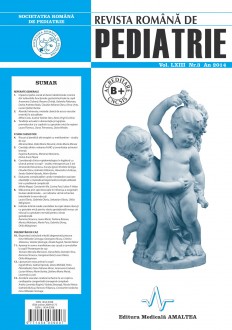SELECT ISSUE

Indexed

| |

|
|
|
| |
|
|
|

|
|
|
|
|
|
|
HIGHLIGHTS
National Awards “Science and Research”
NEW! RJP has announced the annually National Award for "Science and Research" for the best scientific articles published throughout the year in the official journal.
Read the Recommendations for the Conduct, Reporting, Editing, and Publication of Scholarly work in Medical Journals.
The published medical research literature is a global public good. Medical journal editors have a social responsibility to promote global health by publishing, whenever possible, research that furthers health worldwide.
SLEEP APNEA: MANIFESTATION OR CAUSE OF SEIZURES IN CHILDREN? CASE REPORT
Tamara-Marcela Marcovici, Oana Belei, Daniela Chiru, Ramona Stroescu, Giorgiana Brad, Laura Olariu and Otilia Marginean
ABSTRACT
Introduction. Sleep apnea (SA) in children is underdiagnosed. Compromising somatic development and alterated quality of life are frequently present. Central sleep apnea (CSA) may be the cause of convulsive episodes in sleep or could be their result. Polysomnography is the gold-standard of SA objective assessment. Material and methods. We present a 7-year-old boy hospitalized in September 2013 for choking episodes occurred during sleep. The assessment was made by history, clinical examination, laboratory investigations (functional, imaging, biological) and interdisciplinary checkups. Results. Repeated respiratory tract infection and a history of about 20 days of episodes of choking were established by anamnesis. Were diagnosed: underweight status; chronic rhinitis; tonsillar hypertrophy; obstructive ventilatory dysfunction; mixed sleep apnea with predominant central component; atopic status; convulsions. Imaging explorations revealed normal aspects. Complex hygienic-dietary and medical treatment has led to the disappearance of respiratory disorders during sleep, with normalization of spirometric parameters and nutritional status. Conclusions. Polygraphic sleep study identifi ed sleep apnea, indicating the predominance of the central component and facilitating etiologic diagnosis. Interdisciplinary management led to favorable evolution of the case
Keywords: apnea, sleep, convulsion, child
